Aneto: The World’s Most Exceptional Broth
This post may contain affiliate links. See my disclosure policy.
Artes, Spain. This small town on the outskirts of Barcelona is home to Aneto, a broth manufacturer named after the tallest mountain in the Pyrenees. Unless you live in Spain or frequent specialty shops in the U.S. you’ve likely never heard of this broth manufacturer. But as Aneto products continue to make their way across more locations in the United States, Canada and western Europe, you’re bound to come across them. And when you do I hope you’ll stop for a moment, take a carton of broth in your hands, and reflect on what I’m about to share with you.
My husband and I returned from Spain a couple of months ago where we had the most inspiring experience we’ve ever had with anything related to the food industry.
But first let me set the stage so you can put into proper perspective just how radically different – and vastly better – Aneto is from other broth manufacturers.
If you walked into a broth factory, whether they’re the makers of the stuff you avoid or the stuff you pay a premium price for at your local health food store, here is what you would observe: People mixing together a variety of flavored powders, extracts or concentrates in water and pouring that potion into cans or cartons to sell as broth, stock, or just packaging it in bouillon cube form. And that includes those products labeled as “natural” and “organic.” What you wouldn’t see is any sign of a fresh vegetable or a real piece of meat (and in the rare instances that you may see some, it will be in the tiniest of quantities – more on that below). That’s because most broths, from cheap to premium organic, are made from concentrate. And from flavor enhancers used to mimic the real thing (yes, that includes “natural” flavors – more on that later as well). That means that maybe somewhere at some point in the long chain of food-manufacturing that produces the stuff that goes into the broth at the end of the factory line, a real piece of chicken made its way into the powdered or liquid concentrate. But you’ll need a microscope to find it.
To be called “broth” the USDA only requires a Moisture-Protein Ratio (MPR) of 1:135. That’s 1 part chicken to 135 parts water. That translates as 1 ounce of chicken per gallon of water. As unbelievable as that sounds, we’re understandably left asking, “So where’s the chicken in the chicken broth?” But it gets even worse. That one ounce of chicken isn’t even real chicken. Using industry standard terms, that ounce of chicken can be anything from “chicken extract” to “chicken powder”, “chicken by-product” and “pulverized chicken tissue.” Sound appetizing?
So in whatever form that chicken may come, we’re left holding a can or carton of broth with a chicken-to-water ratio of 1:135 and the next question we’re wondering is “so if there’s such little actual chicken in it, where’s all the flavor coming from?” And that’s the question we’re not supposed to ask.
That’s a superb question, one we wish the FDA would answer. Unfortunately they have no definition. In Western Europe the word “natural” comes with strict standards that must be met in order to use that word on any food packaging. Very little that’s passed off as “natural” here would be approved as such overseas. That’s because the U.S. has virtually no standards for the term. And so much of what we buy that’s advertised as “natural” is no different from all the suspect material we try to avoid.
But back to the forbidden question: “So if there’s such little actual chicken in it, where’s all the flavor coming from?” In other words, how can something so ridiculously diluted actually taste like chicken? Two words: Flavor additives. Their purpose is to boost or create flavor where there is none. For chicken broth the flavor additive is creatively named “chicken flavor” (whatever that means). Another is “natural flavor”, a sales gimmick that can mean anything. Other flavor enhancers found in broths and elsewhere are disguised by labels such as “natural seasonings.”
Another common flavor enhancer is “yeast extract.” It sounds pretty benign, doesn’t it? After all, we associate yeast with grandma’s baking. But in fact, yeast extract contains the same concentrated free glutamic acid as MSG. A loophole in FDA regulations, MSG has been replaced by yeast extract as a flavor booster in most processed foods, posing problems for those with MSG sensitivities. Two other commonly used flavor additives that contain MSG are “autolyzed yeast” and “hydrolyzed yeast”.
Sadly, the broths on the market are little more than glorified water with a microscopic hint of chicken that’s flavor-boosted with a ton of undesirable chemicals to make you think you’re eating chicken broth.
Let’s take a look at the ingredients in a few top leading brands, some that have been household names forever and some that are advertised as “healthy”, “natural” and “organic” broth that are found in your local health food stores. The nasty ingredients, sugars or fillers are bolded.
Leading Household Name Brand: Chicken stock, salt, monosodium glutamate, dextrose, yeast extract, chicken flavor, corn syrup solids, chicken fat, hydrolyzed soy protein, dehydrated chicken broth.
(Hydrolyzed soy protein is another flavor enhancer that contains even higher levels of MSG and the process of hydrolyzation produces several other harmful compounds.)
Translated that ingredients list reads, “A bunch of water with a tiny speck of chicken, salt, MSG, sugar, flavor enhancer with MSG, another flavor enhancer, sugar, chicken fat, mega MSG, something dried that was reconstituted.”
Anyone hungry yet?
A Leading “Organic” Broth Brand offers: Chicken Broth (Water, Chicken), Chicken Flavor, Cane Sugar, Yeast Extract, Onion Powder, Rosemary Extract
So the first ingredient, chicken broth, is defined for us as “water, chicken.” Yes, we already know about the 135:1 ratio. And because it’s so watered down we must add a dash of that cryptic ingredient, chicken flavor. Perhaps to camouflage the weird aftertaste, we add some sugar (who adds sugar in chicken broth when making it at home??). And because flavor is still lacking, MSG comes to the rescue in the form of yeast extract. Because there’s a glaring absence of actual broth ingredients (like carrots, celery or leek) we at least find some onion – onion powder. That way we can claim it’s made with veggies. And to pass it off as something gourmet let’s add an herb, albeit rosemary extract. Let me point out that if they were actually making the broth, as in cooking/simmering it with whole foods, extract wouldn’t be necessary.
So is there a real broth on the market that’s made with real, whole foods and without all the junk additives? A flavorful, wholesome broth like the kind grandma used to make?
Yes. Let me introduce you.
What if you picked up a carton of broth and saw this?
That’s Aneto’s ingredients list on the back of their carton of chicken broth. Simple, whole, clean ingredients. That’s it. No flavor enhancers of any kind, no fillers, no “natural flavors.” So where does all the flavor in Aneto’s broths come from? The flavor comes from the real, whole ingredients! And from large quantities of real, fresh chicken!
Aneto’s ingredients are so refreshingly simple and healthy compared with the food manufacturing world as a whole. But the remarkableness of Aneto’s products, the thing that sets them apart, goes far beyond the purity of their list of ingredients: It’s also their method of making broth that is unlike any other broth manufacturer in the world. And as dramatic as that sounds, it’s quite the opposite: At Aneto they’re making broth the way that we – you and I – make it in our own kitchen.
They make it from scratch. They follow a recipe. And they use pure, whole ingredients – without any concentrates, sneaky fillers, flavor enhancers or additives. In every sense of the word it really is 100% natural.
As for the chicken, it’s real and in generous amounts. They use whole fresh chickens because that’s not only where the flavor lies, but the nutrition also: The nutrition is largely in the bones and it’s also from the breakdown of collagen and muscle tissue that gives good chicken broth its rich body and texture. And that breakdown is accomplished by Aneto’s good old-fashioned method of slow-simmering for hours.
It all sounds almost too good to be true, doesn’t it? And that’s what bowled us over to the point where I was actually feeling emotional during parts of their factory tour. Emotional. In a broth factory! Seriously, I was that overcome by the purity and honesty of their approach to broth. Throughout our tour I kept thinking about two things: (1) my frustration with the broths that are passed off as wholesome back home and the general lack of awareness about it, and (2) my excitement about returning home to share what I had found with others.
Yes, for going on 20 years Aneto has had the audacity to do something completely radical: Make broth the way you make it at home.
Let’s see how they do it.
My husband and I were in Spain a couple of months ago and Aneto invited us to take a personal tour of their factory near Barcelona, something they regularly invite people to do. Their open-door policy and transparency is truly remarkable and in stark contrast to the attitudes and secretiveness of many food manufacturers.
Our family has been a fan of Aneto’s broths for over two years now and it was so awesome to be able to tour their factory. It’s made us appreciate Aneto’s products all the more.
Left to right: Alba (Aneto’s food scientist & product developer), Me and Joaquim (Aneto’s CEO)
For 40 years, Aneto was a respected producer of Serrano hams and cured charcuterie. About 13 years ago they shifted to producing what we consider the finest artisan broths in the world.
Let’s head inside the factory and show you what we observed ourselves.
Different days are dedicated to making different kinds of broth and were were there on the day slated for chicken broth.
The first room was the prep room loaded with massive crates of the freshest vegetables. It was almost like walking through a farmer’s market.
In this portion of the factory we saw two people in clean white scrubs coarsely chopping up the fresh vegetables.
Cabbages, leeks, celery, onions, carrots and more. The aroma of fresh vegetables filled the room.
One by one they grabbed fresh vegetables, cut and sliced them and placed them in tubs of water to give them a final washing.
The process was methodical, thorough and very organized. And everything was done by hand with close and immediate oversight of every step in the process.
The vegetables were carted out and placed into what looked like huge metal colanders along with fresh whole, free-range chickens.
These big colanders were then attached to long chains that would soon lift them to the massive pots for simmering.
The process that followed was absolutely incredible – because it was so simple. So wholesome. So exactly like homemade.
The huge colanders, packed to the brim with fresh vegetables and chicken, were lifted up and then lowered into enormous stock pots filled with water.
These huge stock pots were designed by Aneto and are used exclusively by them.
We were able to climb up to the second level and watch as the broth was prepared.
Water filled into the pot and it was slowly heated.
You would think that a broth manufacturer would want to accelerate the process to increase the volume of their production. Not so with Aneto. All of their broths are simmered low and slow for a minimum of 3 hours. That allows the needed time to not only maximize the flavor but to break down the collagen and muscle of the chicken pieces for optimal nutrition, body and texture.
If only you could have been in that room with us while those mass quantities of chicken broth were being simmered – oh, the heavenly aroma!
For some of their broths, like certain meat broths and their seafood broths, they have special ovens in which they first bake or roast the meats and seafood (eg, crab, lobster, etc) for an especially rich and vibrant flavor.
We were there just in time to witness completion of one batch of chicken broth.
Can you imagine standing over an enormous pot of slow-cooked chicken broth like this? I just wanted to keep inhaling!
We observed how the broth is filtered down out of the pot, leaving the fat to float on top to be skimmed off. The broth is then put through a second filter to remove more fat. At the end the pot is left with all the leftover cooked vegetables and chicken at the bottom. We were able to sample those delicious vegetables, pick some of the chicken meat off the bones, and were then given a cup of the freshly made hot broth. (Incidentally, none of these leftovers go to waste: Aneto immediately ships them off to producers of healthy animal feed.)
This is broth production at its very best.
I mentioned before that Aneto makes different broths on different days and after our tour we were able to sample several of them, including ones not yet on the U.S. market. In all we’ve tried more than a dozen of Aneto’s broths. They are all absolutely incredible and the flavors are so fresh and vibrant!
A particularly delicious broth is their Jamón broth, the first broth Aneto ever created. It’s made with Jamón Ibérico, Spain’s famous and highly prized cured ham. Imagine a broth made with smoked ham hocks, then imagine it’s a hundred times better. That’s Aneto’s Jamon broth. They don’t currently sell that one in the U.S. but I have a feeling it’s coming and I hope it does!
As the tour continued we saw the broth cooling and packaging machines. Throughout production, multiple safety measures are in place to maintain product purity. The Aneto staff answered every question we had (and we had a lot of them) and the entire process from beginning to end was absolutely fascinating.
The packaging room was also fun to observe. I don’t have a picture of it but the speed at which the cartons were formed and filled was amazing. We observed rigorous quality control each step along the way to ensure a flawless product.
Bricks and bricks of broth came pouring out of the packaging machine onto conveyor belts that were then gathered and boxed for shipping.
Included in Aneto’s lineup is their new artichoke broth, used as a detox drink. (We sampled some later on after the tour and I’ll just say this: It works!)
Aneto also has a line of delicious low salt and no-salt broths. Throughout Spain medical pharmacies carry those for people on special diets.
In addition to the broths, Aneto also has a line of gourmet paella cooking bases. You simply add them to the rice along with your vegetables and meats or seafood and your paella will taste amazing! I brought two paella pans back with us from Spain and making paella with Aneto’s paella bases has practically become a tradition in our home. Check out my recipe for Valencian Paella!
There are several more broths that Aneto makes that aren’t pictured here.
And Aneto is constantly (and literally) brewing up new ideas and products. I can’t wait to sample what comes next!
Once the tour of the factory was done we headed back upstairs for some lunch and to check out Aneto’s test kitchen.
Alba (left) is in charge of product development and interestingly, besides being a food scientist and product developer, she’s also a food blogger in her spare time.
Alba develops recipes for new broths, paella bases and other products in Aneto’s test kitchen. She uses the same equipment that they do downstairs in the factory, just on regular everyday scale. She packs fresh vegetables, meats or seafood into a metal colander and slowly simmers it in a stock pot. The Aneto staff will all taste the broth and weigh in with their opinions to adjust certain ratios or tweak certain ingredients. The final recipe is then taken downstairs and produced on a large scale.
It’s really that simple. And it’s really that spectacular. You see, at Aneto they don’t create formulas. They create recipes.
Yes, Aneto is doing something truly revolutionary: They’re making food the right way. The wholesome way. The natural way.
Meeting the wonderful staff at Aneto was also a real privilege. I have never met with a team of professionals that was more genuine, passionate, committed and friendly as the team at Aneto. Meeting with them felt like I was among dear friends.
From left to right: Joaquim (CEO), Nuria (Marketing Director), Me, Alba (Food Scientist/Product Developer), Josep (Social Media Manager)
Todd and I came away energized and excited by what we saw, heard and tasted.
Truly, touring the Aneto facility was the most encouraging and inspiring experiences we’ve ever had in the food manufacturing industry.
In summary, at Aneto the process is as simple as the one you follow in your own kitchen: They wash and chop fresh vegetables, use quality free-range chicken, then lower everything into a pot of water to simmer over low temperature for several hours.
Aneto’s broths are 100% made from scratch. No concentrates, no fillers, no flavor enhancers – no additives of any kind. In every sense of the word, Aneto broths are 100% natural.
Aneto’s most effective marketing tool is giving out free samples everywhere – nearly 265,000 gallons a year! – because those who try it fall in love.
Try it for yourself! In soups, casseroles, risottos, pasta dishes and sauces. Or simply heat it up and sip away. Aneto broths can be found in store locations across the U.S. as well as on Amazon.
Disclosure: I did not receive any compensation for this post. I published this in a desire to share with you a company and product that I greatly love and respect. A special thank you to my readers for supporting the brands we love!















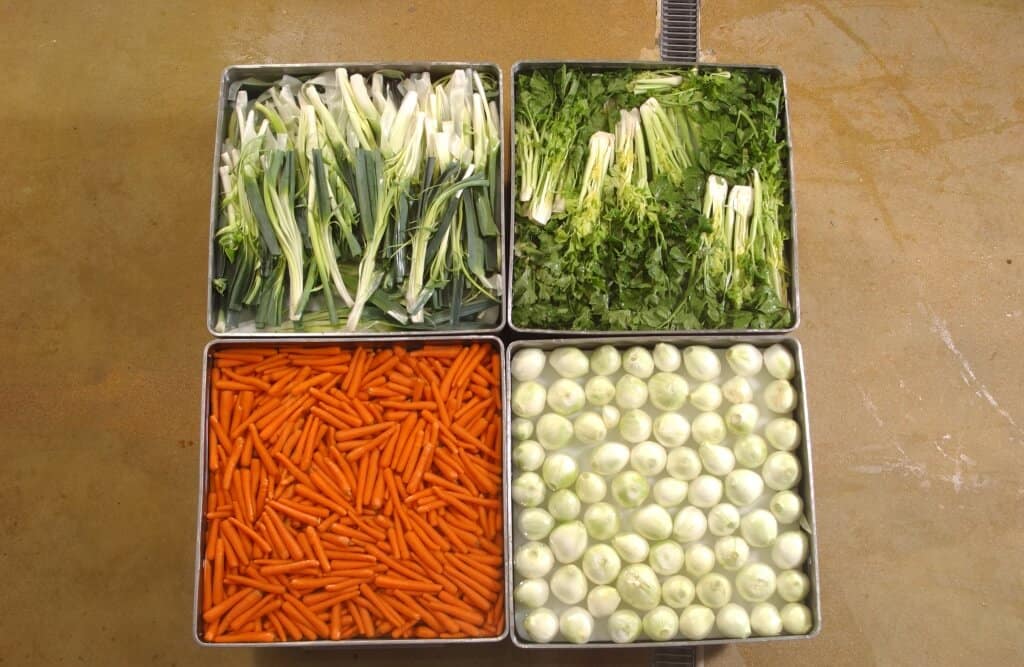




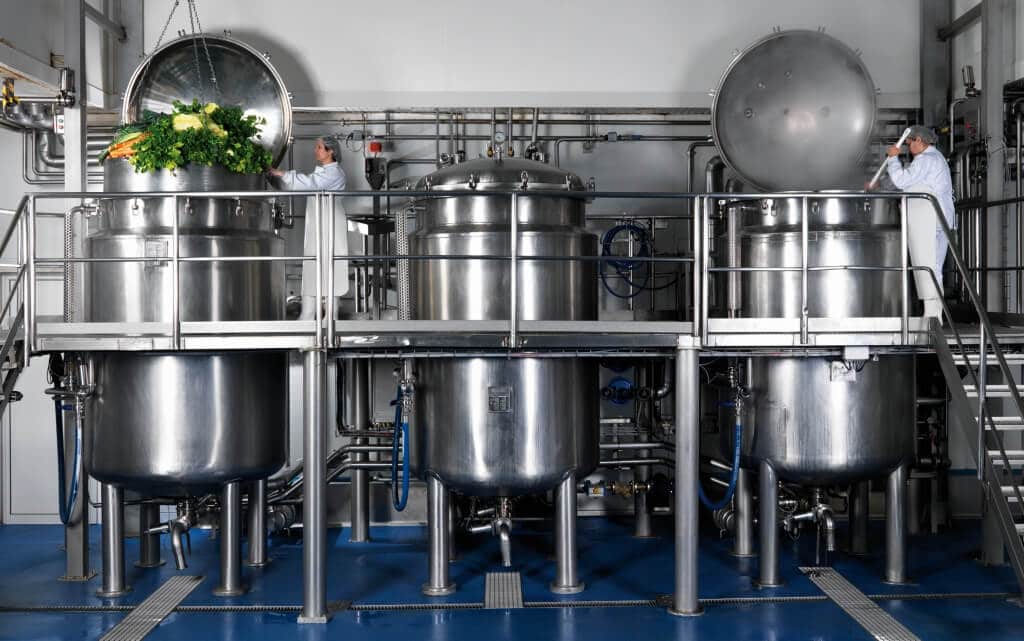




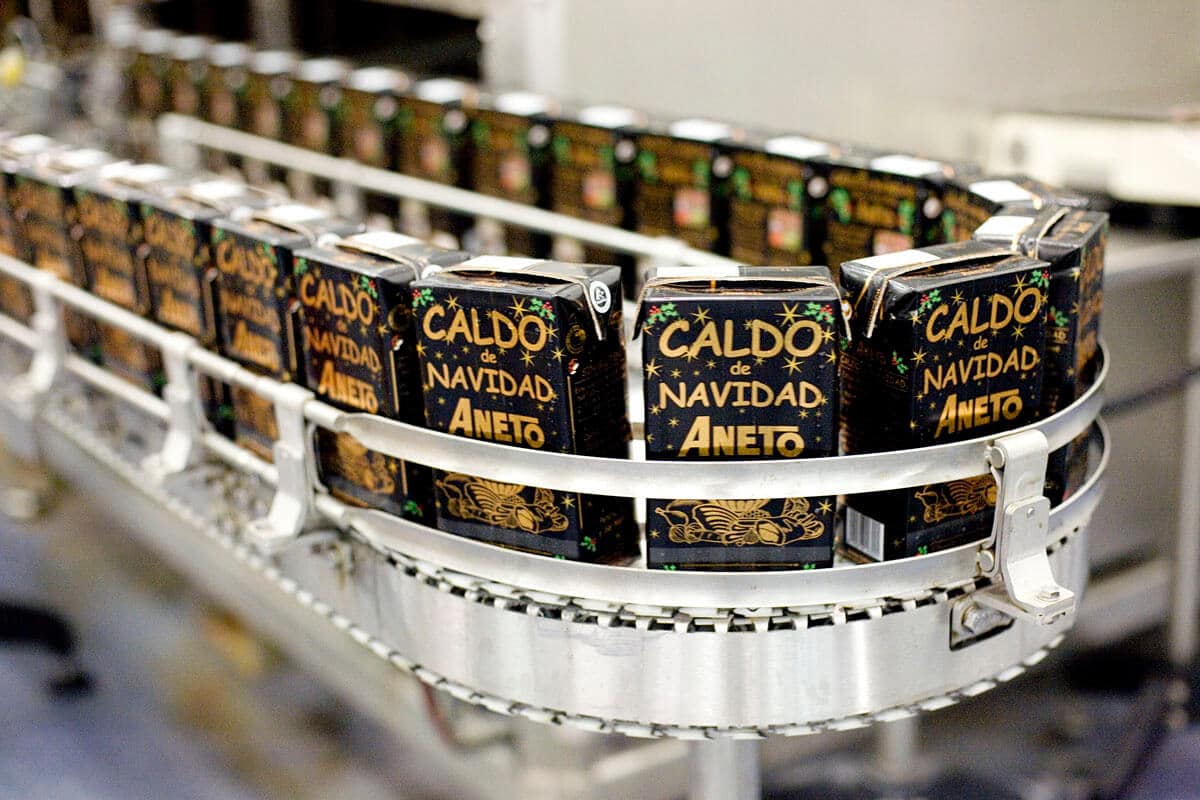



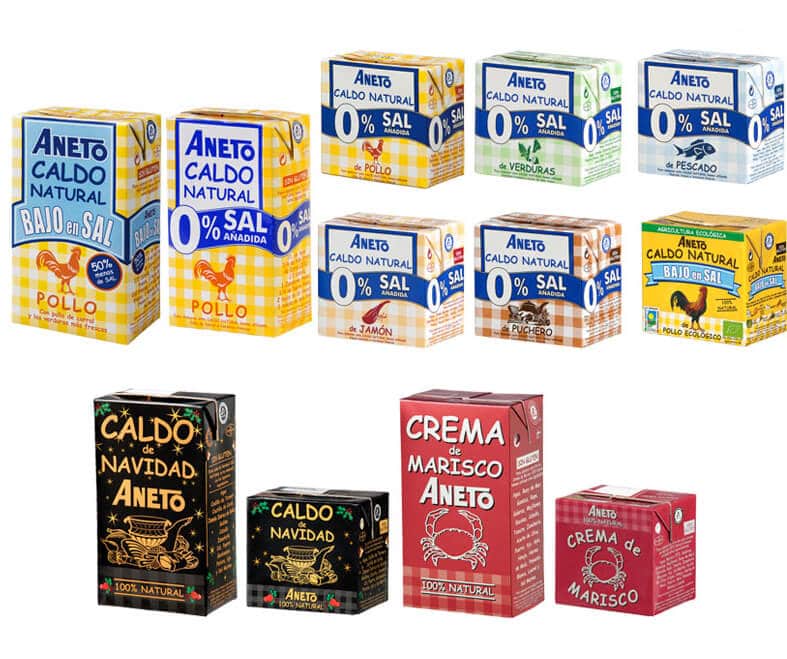





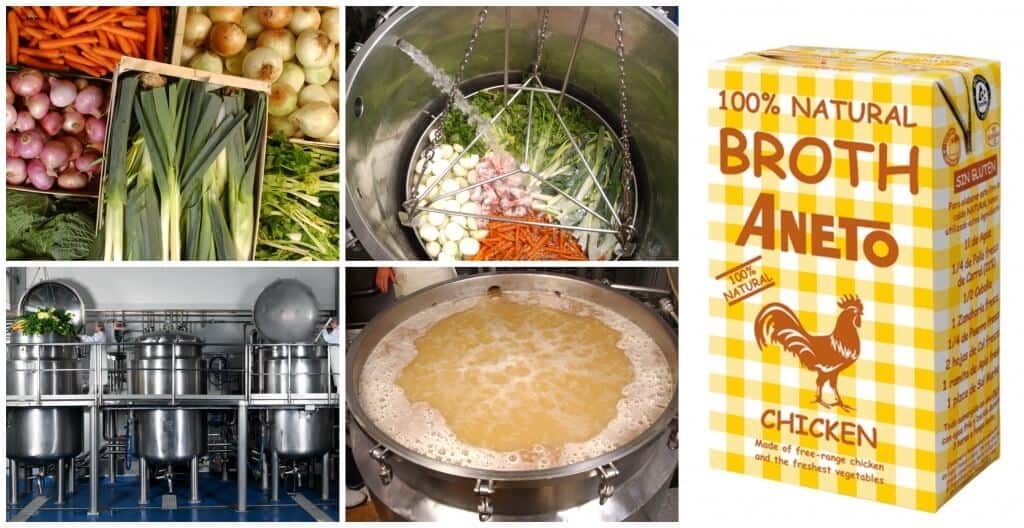


















I was impressed by the huge, custom stockpots and how they lowered the baskets into them.
Also, I love it that they added cabbage and leek to the chicken stock as well as carrot, celery, and onion.
Also, the sheer variety of stocks is amazing!
I was born in Artes (the village were aneto is produced). At home my mom always made homemade chicken broth so I never had to buy aneto’s. Now I don’t live in spain anymore and my grandmother (that lives in that village) bought me some packs and I brought them to Switzerland. Aneto’s broth is the closest to my mom’s chicken soup. I was looking for a way to buy them in switzerland and stepped upon your web. I am very happy to see how people in the US can enjoy this amazing homemade product.
What a small world, Richard, and what a truly remarkable coincidence! We were in Artes last summer and thoroughly enjoyed that beautiful region of Spain. And I still think about our experience touring the Aneto factory every time I open up a carton of Aneto chicken or paella broth…which I seriously just did less than 5 minutes ago! I have a cold right now with bad congestion and I’ve been sipping Aneto’s chicken broth the past two evenings. I just finished heating it up when I opened up my computer and saw your message :) How is that for timing? Thank you so much for sharing your experience with Aneto’s broth, I will be sure to pass that along to staff at Aneto, they will be happy to hear it. If you haven’t already tried their paella cooking bases, you simply must. They are all wonderful but my favorite is the Valencian paella cooking base. Besides its obvious use for paella, I enjoy sipping that plain as well or using it in casseroles, risottos, or just adding some rice or pasta to it for a quick and delicious soup. Have you found a way to purchase Aneto in Switzerland? If not I’m happy to inquire and see what I can find out. Kind regards, Kimberly
At $8.00 per quart, I can do as well myself much more inexpensively. (And I do.)
Yes, homemade is cheaper, Jaye. That’s true for practically anything. The point here is that Aneto makes a storebought broth – the only storebought broth on the market – that’s made in “homemade” fashion for people who may not have the time or desire to make it themselves every time they need chicken broth for a recipe.
Hello from Canada! I’m sold. Although I make my own, as you commented, I don’t always have time. Where, pray tell, can I buy it in Western Canada (Alberta)? Thank you.
Hi Claire! Aneto products are not yet available in Canada but I know they’re working on it :)
I had the seafood paella base in Barcelona this past summer, and I’ve been craving it ever since!
You mentioned that Aneto will be available in Canada “hopefully soon”…do you have any additional information about this?
Thanks!
That’s awesome that you were able to try Aneto while in Barcelona, Rob! I don’t have any updates yet when their products will come available in Canada. In the list I provided about store locations there are also some online options and a couple of those may ship to Canada, I’m not sure. I will be writing more about Aneto in the future though and as soon as they tell me their products are available in Canada I’ll include that info.
I love that these are truly clean. I switched my family to clean eating just in the last month. I can’t believe the changes we’ve already experienced. I am finding out so many things and now with my first 2 grandkids I’m teaching them better health and eating habits. Thank you so much for sharing this.
These sound wonderful. I agree that most puchased broths on the market have little or no flavor or nutrition. I love making my own broths, stocks, and demi-glace and have done so for years, but they are very time consuming and expensive when cooking for one…well worth it, when entertaining! It would be wonderful to have “real” broths. I make lots of soups and stews to give to friends and to stash in the freezer. Without the real thing they just don’t have the flavor I am looking for. The Aneto products seem to be a dream come true. Are they avaiable on-line anywhere?
Hi Jane, yes they are. At the end of this article you’ll see a link to locations in the U.S. where they can be purchased (the link will take you to a new page). At the end of that list you’ll see several online stores that carry it. (For whatever reason Amazon is vastly more expensive than anywhere else, so I’d try a different online store.)
Wow! Another great and informative article Kimberly.
I know of Aneto and their products as I have seen them in Supermercado Lidl and El Corte Ingles’s in Madrid and Barcelona…. I have never tried their products and will now definitely be looking for this online. Unfortunately, it is not available nearby; but after I try it I will “persuade” ;) the Fresh Market here to carry it.
Like other commenters when I am creating a special meal and the substitutes just will not do, I make my own broths, consomme’s and demi-glace. The magical pressure cooker works fine here and you will even end up with useable gelatin for pates.
Were those commercial Fagor appliances in the pictures?
Thanks again for the exceptional research.
Bon appetit! Machen leben lecker.
The process is impressive, just like at home but a much larger scale! It is great to see such fresh products being used.